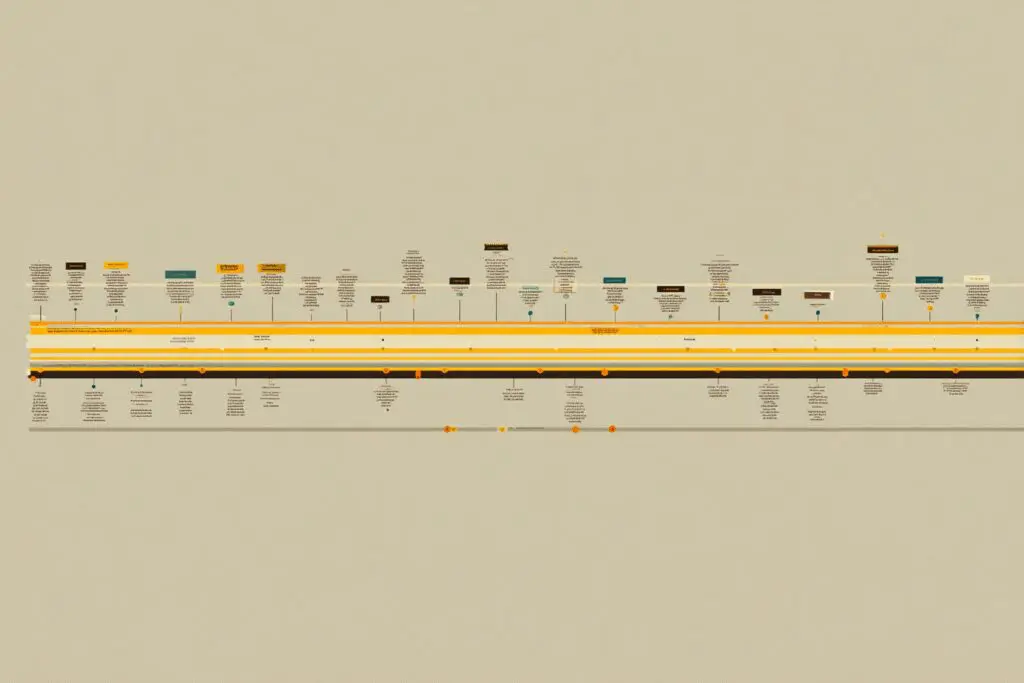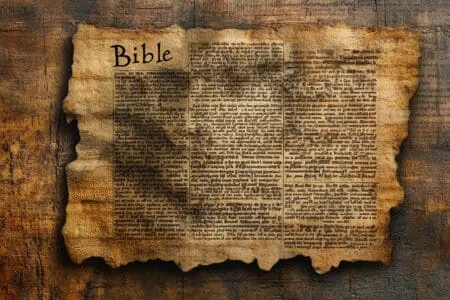I found my grandfather’s old study Bible a few weeks ago while cleaning out the attic. The leather cover was cracked, and the pages were so thin and delicate they felt like onion skin. Tucked inside was a yellowed newspaper clipping from 1982. It made me think—this book in my hands felt ancient, but the original words inside it are on a completely different level of old. It sparked a question I couldn’t shake: when was each book of the Bible actually written?
It sounds like a simple question, but the answer is a fascinating, complex puzzle that takes us back thousands of years. It’s a story not about one book, but a whole library written over a staggering amount of time. If you’ve ever wondered the same thing, you’re in the right place. We’re going to dig into it, not like stuffy academics, but like two curious people trying to figure this out together.
More in Bible Category
How Many Words Are in the KJV Bible
How Many Bible Verses Are There in the Bible
Key Takeaways Before We Dive In
For those who want the quick version, here’s the gist of it:
- It’s a Library, Not a Single Book: The Bible wasn’t written all at once. It’s a collection of 66 books (in the Protestant canon) written by many different authors over about 1,500 years.
- Dating is an Educated Guess: Scholars use historical context, language analysis, and archaeology to estimate dates. For many books, these are best-guess ranges, not exact years.
- The Old Testament is Old: The earliest books were likely first written down around 1400 BC, but many stories existed in oral tradition long before that. The OT was written and compiled over more than a thousand years.
- The New Testament is More Compact: All the books of the New Testament were written within a single century, roughly between 50 AD and 100 AD.
- The Order Isn’t Chronological: The books in the Bible are arranged thematically (law, history, poetry, etc.), not in the order they were written. In fact, some of the very first Christian writings were letters from the Apostle Paul, not the Gospels.
So, How Do We Even Know This Stuff? Is It Just Guesswork?
Before we get to the list, it feels right to ask how anyone figures this out. It’s not like the authors put a copyright date at the bottom of the scroll. When I first started looking into this, I was pretty skeptical. It seemed like a lot of speculation. But it turns out, scholars have some clever methods for piecing the timeline together.
It’s a bit like being a historical detective. They don’t have just one clue; they have several different types of evidence that they use to build a case for a particular date range.
The Detective Toolkit for Dating Biblical Books
- Internal Clues: Sometimes, the book itself gives you hints. Does it mention a specific king, a known battle, or a particular city that we know existed at a certain time? For example, the prophet Jeremiah mentions the Babylonian invasion of Jerusalem, which gives us a solid historical anchor point around 586 BC.
- Language and Style: Languages evolve over time, just like how we don’t speak like Shakespeare anymore. Scholars can analyze the Hebrew or Greek and see if it’s an early, classical, or later form of the language. Different authors also have unique writing styles, and scholars can spot where one author’s voice seems to end and another’s begins within the same book.
- Archaeological Discoveries: This is the really cool stuff. Discoveries like the Dead Sea Scrolls were a game-changer. Found in caves in the 1940s, these scrolls contained pieces of almost every Old Testament book, and some were dated to as early as the 3rd century BC. This gave us a physical snapshot, proving the texts were already ancient by the time of Jesus. It provided a hard “written-by” date for many books.
- How They Talk About History: You can often tell when something was written by what history it knows about. If a book of prophecy describes events up to a certain point with stunning accuracy and then gets vague about everything after, it’s a good clue it was written around that “pivot” point.
It’s not a perfect science, and that’s why you’ll almost always see a date range. There’s a lot of debate among honest experts. It’s less about finding a single, magic date and more about finding a plausible window of time.
Let’s Start with the Old Testament: A Story a Thousand Years in the Making
The Old Testament is the big one, covering a massive sweep of history. The writing here wasn’t a continuous project. It was a collection of stories, laws, poems, and prophecies gathered over centuries.
The first five books (Genesis, Exodus, Leviticus, Numbers, Deuteronomy) are called the Torah or the Pentateuch. Traditionally, Moses was considered the author, which would place their writing around 1400 BC. That’s a good starting point, but most scholars today think the reality is a little more complicated. They see the fingerprints of several different authors and editors who compiled these stories over a long period, from about 950 BC to 550 BC.
It doesn’t mean the stories aren’t ancient. Many of them, like the accounts of Abraham, Jacob, and Joseph, were likely passed down orally for generations before anyone wrote them on a scroll.
So, What’s the Timeline for the Old Testament Books?
Alright, let’s get to the list. I’ve broken it down into logical groups. Remember, these dates are the best estimates from a ton of research and are often debated. Think of them as really good “best guesses.”
The Pentateuch (The Law)
These books cover the creation of the world, the story of the patriarchs, the exodus from Egypt, and the laws given to Israel.
- Genesis, Exodus, Leviticus, Numbers, Deuteronomy: The events described span from creation to around 1400 BC. However, the final written form we have today was likely compiled and edited between 950 and 500 BC.
The Historical Books
This is the story of Israel, from conquering the promised land to their exile and return.
- Joshua: Written around 1380-1045 BC. It picks up right where Deuteronomy leaves off.
- Judges: Likely written between 1045 and 1000 BC.
- Ruth: Traditionally written around 1000 BC.
- 1 & 2 Samuel: These were originally one book. They cover the lives of Samuel, Saul, and David. Written between 930 and 722 BC.
- 1 & 2 Kings: Also originally one book, continuing the story of Israel’s kings until the Babylonian exile. Written between 560 and 540 BC.
- 1 & 2 Chronicles: These books retell much of the history from Samuel and Kings but from a different perspective, likely after the exile. Written around 450-400 BC.
- Ezra & Nehemiah: These cover the return from exile and the rebuilding of Jerusalem. Written around 430-400 BC.
- Esther: The story is set in Persia, and it was likely written between 460 and 350 BC.
The Wisdom and Poetry Books
These are less about historical narrative and more about grappling with life, faith, and God.
- Job: This is one of the hardest to date. It’s an ancient, timeless story. Some scholars place it as early as the time of the patriarchs, while others think it was written down around 600-500 BC.
- Psalms: This is a collection of 150 songs and prayers written over a huge span of time. King David wrote many of them around 1000 BC, but others were written as late as the 500s BC. The whole collection spans 1000 to 500 BC.
- Proverbs: Many are attributed to Solomon (around 950 BC), but the book was likely compiled and added to over time, finishing around 700 BC.
- Ecclesiastes: Also attributed to Solomon, but the language suggests it might have been written later, around 935 BC or perhaps as late as the 3rd century BC.
- Song of Solomon (or Song of Songs): Another one traditionally linked to Solomon, likely written around 950 BC.
The Prophets: Speaking Truth to Power
The prophetic books are divided into the Major Prophets (longer books) and the Minor Prophets (shorter books). They were written by men who spoke on God’s behalf, often calling kings and the people back to their faith during times of crisis. They are some of the most precisely dated books because they are often tied to specific historical events.
The Major Prophets
- Isaiah: This book seems to have two, maybe three, distinct sections. The first part (chapters 1-39) was likely written by the prophet Isaiah himself between 740 and 680 BC. The later parts were likely written by his followers later, around 540-500 BC.
- Jeremiah: The prophet Jeremiah was active during the fall of Jerusalem. The book was written between 627 and 586 BC.
- Lamentations: A book of mourning over Jerusalem’s destruction, written by Jeremiah shortly after the event, around 586 BC.
- Ezekiel: Ezekiel was a prophet in exile in Babylon. He wrote his prophecies between 593 and 571 BC.
- Daniel: This is another tricky one. The stories are set during the Babylonian exile (around 500s BC), but many scholars, due to the linguistic style and prophetic details, believe the final version was written much later, around 165 BC.
The Minor Prophets
- Hosea: Written between 750 and 715 BC.
- Joel: The date is highly debated. It could be anywhere between 835 BC and 400 BC.
- Amos: Written around 760-750 BC.
- Obadiah: Written shortly after Jerusalem’s fall, around 586 BC.
- Jonah: Likely written around 785-760 BC.
- Micah: Written between 742 and 687 BC.
- Nahum: Written between 663 and 612 BC.
- Habakkuk: Written between 612 and 588 BC.
- Zephaniah: Written around 640-621 BC.
- Haggai: Written in a very specific year, 520 BC.
- Zechariah: Written between 520 and 518 BC.
- Malachi: The last book written in the Old Testament, around 430 BC.
Whew. That’s a lot. What strikes me is the huge gap after Malachi. For about 400 years, there was silence. No new scripture was written. This is what’s known as the intertestamental period. And then, a man named John the Baptist appeared in the desert, and everything changed.
What About the New Testament? A Much Different Story
If the Old Testament was a slow-simmering epic, the New Testament was an explosion. All of it was written in a window of less than 70 years, from about 50 AD to the late 90s AD. The authors were eyewitnesses or people who had interviewed eyewitnesses to the life, death, and resurrection of Jesus Christ.
This proximity to the events is a huge deal. It’s not mythology that developed over centuries; it’s a collection of accounts and letters written within the lifetimes of people who were there. For a deep dive into the reliability of these texts, Duke University has an excellent guide on the manuscript evidence for the New Testament, which is fascinating if you like that kind of thing.
Who Wrote First, Paul or the Gospel Guys?
Here’s a fun fact that surprises a lot of people: the Gospels (Matthew, Mark, Luke, John) were not the first New Testament books to be written. The earliest Christian writings we have are actually letters written by the Apostle Paul.
Paul was traveling around the Roman Empire planting churches, and he wrote letters back to these young congregations to encourage them and sort out problems. These letters, like 1 Thessalonians or Galatians, were being circulated before the Gospel of Mark was even written.
The New Testament Book-by-Book Breakdown
Here’s the estimated timeline for the New Testament books.
The Gospels and Acts
These books tell the story of Jesus’s life and the birth of the early church.
- Matthew: Written around 60-70 AD.
- Mark: Believed to be the first Gospel written, around 55-65 AD.
- Luke: Written around 60-68 AD.
- John: The last Gospel written, with a very different, more theological style. Written between 80 and 95 AD.
- Acts: The sequel to Luke, written by the same author, around 62-70 AD.
Paul’s Letters (The Pauline Epistles)
These are letters to specific churches or individuals, arranged by length, not by date. Here they are in their likely chronological order:
- Galatians: 48-49 AD (Possibly Paul’s very first letter).
- 1 & 2 Thessalonians: 50-51 AD.
- 1 & 2 Corinthians: 55-56 AD.
- Romans: 57 AD.
- Ephesians, Philippians, Colossians, Philemon: These are the “Prison Epistles,” written while Paul was imprisoned in Rome, around 60-62 AD.
- 1 Timothy, Titus: Written around 64 AD.
- 2 Timothy: Paul’s final letter, written from a Roman prison just before his death, around 66-67 AD.
The General Epistles and Revelation
These are letters written by other apostles and church leaders, along with the final, prophetic book of the Bible.
- Hebrews: The author is unknown, but it was likely written before the destruction of the temple, around 65-69 AD.
- James: Possibly the earliest book in the New Testament, some scholars date it as early as 45-49 AD.
- 1 & 2 Peter: Written by the Apostle Peter between 64 and 67 AD.
- 1, 2, & 3 John: Written by the Apostle John around 90-95 AD.
- Jude: Written around 65-80 AD.
- Revelation: The final book, a vision of the end times written by the Apostle John while in exile on the island of Patmos, around 95 AD.
So, Does Knowing All This Actually Change Anything?
Looking at these dates, you might wonder if it’s all just historical trivia. But for me, it actually makes the Bible feel more real and grounded.
Understanding the context changes how you read it. When you know Jeremiah was writing as his city was literally being torn down around him, his words of sorrow and hope carry a different weight. When you read Paul’s letter to the Philippians and realize he’s writing from a dark prison cell, his talk of finding joy in all circumstances becomes breathtaking.
It shows that the Bible isn’t a flat, one-dimensional rulebook. It’s a dynamic collection of human experiences across thousands of years. It’s about real people in real places struggling with real problems.
From Scattered Scrolls to a Single Book
The final piece of the puzzle is understanding that for hundreds of years, these books existed as separate scrolls. There was no “Bible” yet. It took time for the early church, guided by a sense of which writings were divinely inspired, to collect and formally recognize these specific books as scripture. This process, called canonization, was largely complete by the late 300s AD.
That’s a whole other fascinating story. But the point is, the book you can hold in your hands today is the result of a long, incredible journey. From stories told around a campfire to words scratched onto papyrus to a library that has shaped the world.
Looking at my grandpa’s old Bible now, it feels different. It’s not just an old book. It’s a time capsule. It contains some of the oldest and most influential words ever recorded, a conversation between God and humanity that has been going on for thousands of years. And figuring out “when” it was all written makes that conversation feel that much more alive.
Frequently Asked Questions – When Was Each Book of the Bible Written

Why is the dating of some biblical books, such as Job or Song of Songs, more complex?
Dating is complex because these books contain language, themes, and references that span from early to later periods. For example, Job is believed to be from around 2000-1800 B.C. based on story content but has ideas that suggest a later date, around 600-400 B.C. Similarly, Song of Songs’s language suggests it was written between the 5th and 3rd centuries B.C., making precise dating challenging.
Which books of the Bible are believed to be written by the Apostle Paul and what are their approximate dates?
The undisputed Pauline epistles, written by Paul, include 1 Thessalonians (A.D. 50-51), Galatians (A.D. 50-55), 1 Corinthians (A.D. 53-55), 2 Corinthians (A.D. 55-56), Romans (A.D. 56-57), Philippians (A.D. 60-62), and Philemon (A.D. 60-62). These are widely attributed directly to Paul.
When were the books of the New Testament written?
The books of the New Testament were written over approximately 70 years in the first century A.D. The earliest, like Paul’s epistles, date from around A.D. 50-60, while the Gospels were written between A.D. 66 and 110, and Revelation around A.D. 95.
How do experts determine the dates when the books of the Bible were written?
Experts look at ancient texts, historical context, language, and source materials to estimate writing dates. They analyze clues within the texts themselves, compare them with archaeological and historical evidence, and consider tradition and biblical scholarship to piece together the most probable timeline.




